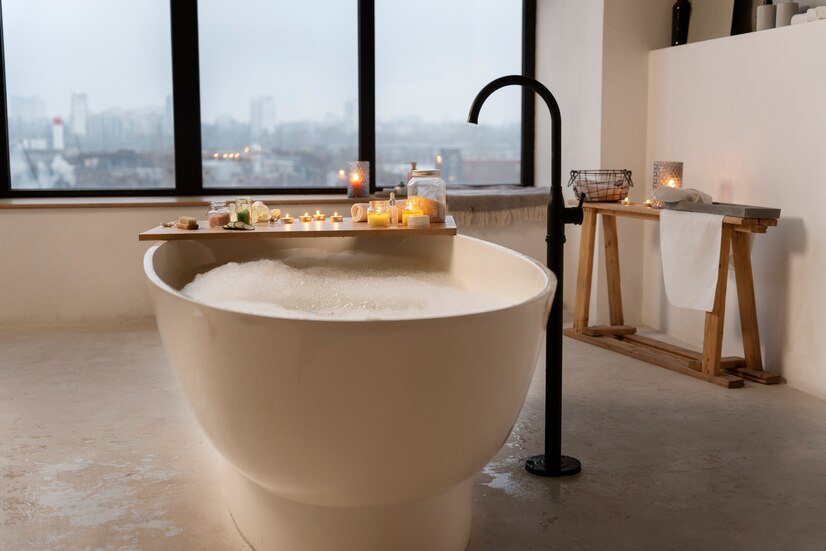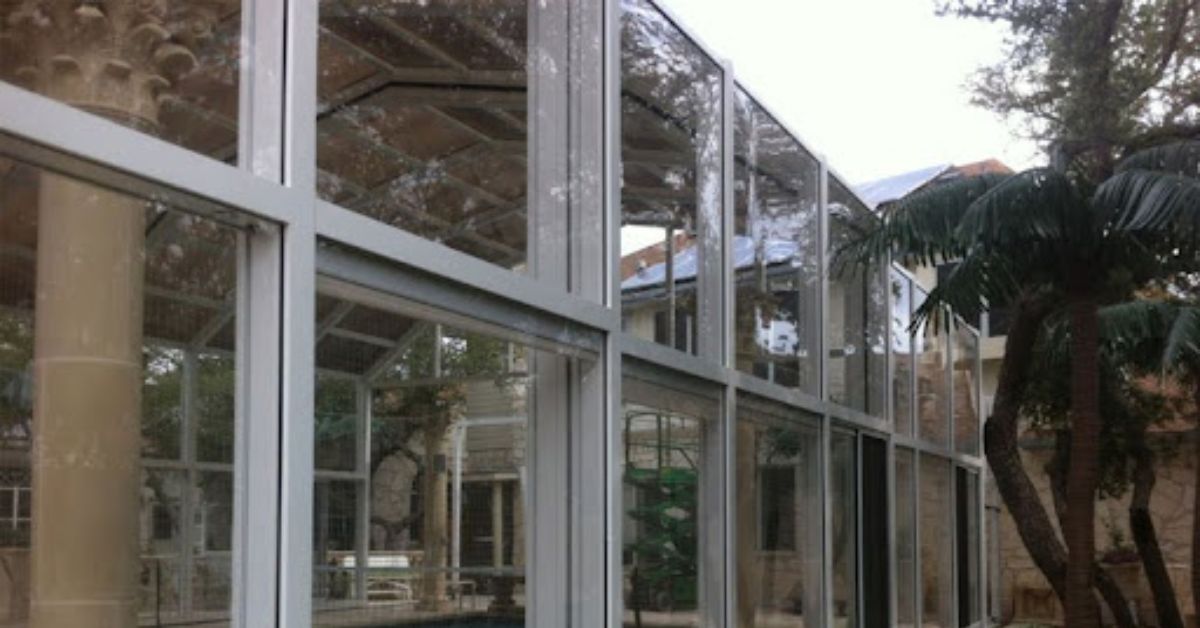HOME IMPROVEMENT
Modern Bathroom Makeover: Tub to Shower Conversion

The Process of Tub to Shower Conversion
Updating your bathroom with a tub to shower conversion can transform the space into a modern, functional, and visually appealing area. The conversion process involves several steps, each critical to achieving a seamless and professional result. Here’s a detailed guide to understanding the entire procedure:
- Assessment and Planning: The first step in a tub to shower conversion is to assess the existing bathroom layout and determine how the new shower will fit into the space. This involves measuring the area, evaluating the condition of the current plumbing, and identifying any structural changes needed. A detailed plan is then created, including the design, materials, and features to be incorporated.
- Demolition: With a clear plan in place, the next step is to remove the existing bathtub and surrounding materials. This demolition process involves disconnecting the plumbing, cutting away the tub, and removing any tile or wall coverings. It’s essential to protect the rest of the bathroom from dust and debris during this phase.
- Plumbing Adjustments: Once the bathtub is removed, adjustments to the plumbing are often necessary. This may include relocating the drain, installing new water supply lines, and setting up the plumbing for the new showerhead and controls. A licensed plumber should handle these tasks to ensure compliance with local codes and proper functionality.
- Framing and Drywall: Depending on the size and design of the new shower, additional framing may be required. This step involves constructing any new walls or niches and reinforcing the existing structure. Drywall is then installed, and waterproofing measures are applied to prevent moisture damage.
- Shower Pan Installation: The shower pan, or base, is a critical component that ensures proper drainage and prevents leaks. It must be installed correctly, with a slight slope towards the drain. Shower pans are available in various materials, including acrylic, fiberglass, and custom-tiled options.
- Waterproofing and Tiling: Proper waterproofing is essential to protect against water damage and mold growth. A waterproof membrane is applied to the shower walls and floor before tiling begins. The choice of tiles can significantly impact the overall look of the shower, so select materials that match your style and are suitable for wet environments.
- Fixture Installation: After the tiles are set and the grout has cured, the shower fixtures are installed. This includes the showerhead, controls, and any additional features such as handheld showerheads or body sprays. Ensure that all fixtures are securely mounted and functioning correctly.
- Shower Door or Enclosure: The final step in the conversion process is installing the shower door or enclosure. Frameless glass doors are a popular choice for their sleek appearance and ease of cleaning. Alternatively, you may opt for sliding doors or a partial glass panel, depending on the design.
- Final Inspection and Cleanup: Before using your new shower, a final inspection ensures that all components are correctly installed and functioning. Any remaining construction debris is cleaned up, leaving your bathroom ready for use.
Benefits of Upgrading Your Outdated Bathtub
Upgrading an outdated bathtub to a modern shower offers numerous benefits, from increased functionality to enhanced aesthetics. Here are some of the key advantages of making this switch:
- Improved Accessibility: Traditional bathtubs can be challenging to access for individuals with mobility issues, seniors, or those with disabilities. Walk-in showers eliminate the need to step over a high tub wall, making them safer and more accessible for everyone.
- Space Optimization: Bathtubs often take up a significant amount of space in a bathroom. Converting a tub to a shower can free up valuable floor space, making the bathroom feel larger and more open. This is particularly beneficial in smaller bathrooms where maximizing space is crucial.
- Modern Aesthetic: Walk-in showers offer a sleek, contemporary look that can instantly update the appearance of your bathroom. They can be customized with a variety of materials, finishes, and features to match your personal style and create a cohesive design.
- Ease of Maintenance: Bathtubs can be difficult to clean, especially in hard-to-reach areas. Walk-in showers, particularly those with frameless glass enclosures and minimal grout lines, are much easier to maintain. This reduces the time and effort required to keep the bathroom clean and sanitary.
- Enhanced Home Value: A bathroom remodel, including a tub to shower conversion, can increase the value of your home. Prospective buyers often look for modern, updated bathrooms, and a stylish walk-in shower can be a significant selling point.
- Increased Comfort: Walk-in showers can be equipped with various features that enhance comfort and convenience. From multiple showerheads and body sprays to built-in seating and storage niches, these showers can provide a luxurious and spa-like experience.
- Water Efficiency: Showers generally use less water than baths, making them a more environmentally friendly option. By converting to a shower, you can reduce your water consumption and lower your utility bills.
- Customizability: Walk-in showers can be tailored to meet your specific needs and preferences. Whether you want a simple, functional design or a high-end, luxurious shower, the options are virtually limitless.
Tips for Designing a Stylish Shower
Designing a stylish shower involves careful consideration of various elements, from the layout and materials to the fixtures and accessories. Here are some tips to help you create a beautiful and functional shower space:
- Choose a Focal Point: A focal point can anchor the design of your shower and draw the eye. This could be an accent wall with a bold tile pattern, a statement showerhead, or a unique feature such as a built-in bench or niche.
- Use High-Quality Materials: Invest in high-quality materials that are durable and easy to maintain. Porcelain and ceramic tiles are popular choices for their versatility and resistance to water. Natural stone can add a luxurious touch but requires more maintenance.
- Opt for Neutral Colors: Neutral colors such as white, gray, and beige create a timeless and elegant look. They also make the space feel larger and more open. You can add pops of color through accessories like towels, rugs, and decorative items.
- Incorporate Textured Tiles: Textured tiles not only add visual interest but also improve safety by providing better traction. Consider using textured tiles on the shower floor or as an accent on the walls.
- Select Modern Fixtures: Sleek, modern fixtures can enhance the overall aesthetic of your shower. Rain showerheads, wall-mounted faucets, and minimalist grab bars are excellent choices that combine functionality with style.
- Add Smart Storage Solutions: Built-in niches, corner shelves, and floating vanities provide convenient storage for toiletries and keep the shower area clutter-free. Ensure that storage solutions are accessible and do not obstruct the shower space.
- Consider Glass Enclosures: Frameless glass enclosures create a seamless transition between the shower and the rest of the bathroom, making the space feel more open. They also allow natural light to flow through, enhancing visibility and safety.
- Incorporate Lighting: Proper lighting is essential for both functionality and ambiance. Use a combination of overhead lighting, task lighting, and accent lighting to create a well-lit and inviting shower space. LED lights are energy-efficient and can be used to highlight specific features.
- Include Greenery: Adding plants to your bathroom can create a calming and spa-like atmosphere. Choose moisture-loving plants such as ferns, bamboo, or orchids that thrive in humid environments.
- Personalize with Accessories: Small details such as towel hooks, soap dispensers, and shower mats can personalize your shower and add a touch of style. Choose accessories that complement the overall design and enhance the functionality of the space.
Maintaining Your New Shower
Maintaining your new shower is essential to keep it looking and functioning at its best. Here are some tips to help you care for your upgraded shower:
- Daily Wipe-Down: Wipe down the shower walls and floor after each use to prevent soap scum and water spots. A squeegee or microfiber cloth can make this task easier and more effective.
- Regular Deep Cleaning: Conduct a thorough cleaning of the shower at least once a week. Use non-abrasive cleaners that are safe for your specific materials, such as tiles, grout, and fixtures. Pay special attention to areas prone to buildup, such as grout lines and corners.
- Seal Grout and Stone: If your shower features natural stone or grout, regular sealing is necessary to protect these materials from moisture and staining. Follow the manufacturer’s recommendations for sealing frequency and products.
- Inspect for Damage: Regularly inspect the shower for any signs of damage, such as cracks in the tiles, loose grout, or broken fixtures. Address any issues promptly to prevent further damage and ensure the shower remains safe and functional.
- Ventilate the Bathroom: Proper ventilation is crucial for preventing moisture buildup and reducing the risk of mold and mildew. Use an exhaust fan or open a window during and after showering to allow moisture to escape.
- Clean Showerheads: Mineral deposits can build up in showerheads over time, affecting water flow and pressure. Remove showerheads periodically and soak them in a solution of vinegar and water to dissolve any deposits.
- Check Seals and Enclosures: Inspect the seals and enclosures regularly for any signs of wear or damage. Replace worn-out seals to prevent water leaks and maintain the integrity of the shower enclosure.
Planning for Future Upgrades
A tub to shower conversion is a significant improvement, but there are other upgrades you can consider to further enhance your bathroom’s functionality and style:
- Upgrade Vanities and Sinks: Modern vanities and sinks can complement your new shower and provide additional storage and convenience. Consider options with sleek designs and durable materials that match the overall aesthetic of your bathroom.
- Install Smart Fixtures: Smart fixtures, such as touchless faucets and smart mirrors, can add convenience and a high-tech touch to your bathroom. These fixtures often come with features like motion sensors, temperature controls, and integrated lighting.
- Enhance Flooring: Upgrading the flooring in your bathroom can create a cohesive and stylish look. Consider materials that are both durable and visually appealing, such as porcelain tiles, luxury vinyl, or engineered wood.
- Add Heated Floors: For a touch of luxury, consider installing heated floors in your bathroom. This feature can provide warmth and comfort, especially during the colder months.
- Incorporate Eco-Friendly Features: Eco-friendly fixtures and materials can reduce your bathroom’s environmental impact and lower utility bills. Consider water-saving showerheads, energy-efficient lighting, and sustainable materials.
- Create a Spa-Like Atmosphere: To further enhance your bathroom’s relaxation potential, consider adding spa-like features such as a soaking tub, steam shower, or aromatherapy diffusers. These elements can transform your bathroom into a personal retreat.
In conclusion, a tub to shower conversion in Frederick is a valuable investment that can transform your bathroom into a more accessible, stylish, and functional space. By following the steps outlined in this guide and incorporating thoughtful design elements, you can create a shower that meets your needs and enhances your home. Regular maintenance and future upgrades can ensure that your bathroom remains a modern, luxurious retreat for years to come.
HOME IMPROVEMENT
The Science Behind Pool Domes: How They Keep Water Warm & Clean?

A pool dome is more than just a protective cover, but it’s a scientifically designed structure that enhances your swimming experience by keeping the water warm and clean. Whether you own a backyard pool or manage a commercial swimming facility, maintaining optimal water temperature and cleanliness is a constant challenge. Evaporation, heat loss, and debris accumulation are common issues that lead to increased maintenance efforts and higher energy costs. Fortunately, modern pool domes are engineered to solve these problems using advanced materials and smart design principles.
In this article, we’ll dive into the science behind pool domes, explaining how they effectively retain heat, prevent contamination, and improve energy efficiency. Ultimately making them a must-have addition for pool owners.

How Pool Domes Trap Heat?
Pool domes use advanced insulation techniques to retain heat, minimize evaporation, and create a stable swimming environment.
1. The Greenhouse Effect
Pool dome functions similarly to a greenhouse. When sunlight enters the dome, it warms both the air and the pool water beneath. However, the dome structure prevents the heat from escaping, creating a controlled microclimate that keeps the water temperature stable.
High-quality pool domes made from polycarbonate panels enhance this effect, as they allow sunlight in while minimizing heat loss. The result? A naturally warmer pool without excessive heating costs.
2. Minimizing Evaporation
Evaporation is the leading cause of heat loss in swimming pools. Without a dome, water constantly evaporates, carrying heat away with it. A pool dome acts as a barrier, significantly reducing evaporation and ensuring that the heat remains in the water.
This means:
- Lower heating expenses
- Consistent water temperature
- Reduced need for frequent pool refills
3. Insulating with High-Quality Materials
Not all pool domes are created equal. Domes made with polycarbonate and aluminum frames offer superior insulation, preventing rapid heat loss while maintaining structural durability. Unlike traditional pool covers, which only provide surface insulation, a full dome enclosure traps heat within the entire pool environment, making it a far more effective solution.
How Pool Domes Prevent Water Contamination?
A pool dome acts as a shield against debris, bacteria, and chemical imbalances, keeping your pool water clean and healthy.
1. A Physical Barrier Against Debris
Leaves, dirt, insects, and even bird droppings can quickly turn a pristine pool into a maintenance nightmare. A pool dome acts as a shield, keeping unwanted debris out. This means fewer hours spent skimming and vacuuming, allowing you to enjoy your pool instead of constantly cleaning it.
2. Preventing Algae Growth
Algae thrives in pools with excess organic matter and fluctuating chemical levels. Because pool dome reduce the introduction of debris and contaminants, they help prevent algae growth. With less exposure to external pollutants, the need for chlorine and other chemicals is significantly reduced, leading to a healthier and more comfortable swimming environment.
3. Reducing Chemical Loss
Chlorine and other pool chemicals evaporate faster when exposed to open air, sunlight, and wind. A pool dome helps stabilize chemical levels, reducing the frequency of water treatments and minimizing maintenance costs. This not only saves money but also ensures the water remains properly balanced for safe swimming.

Role of Pool Dome in Energy Efficiency
Pool dome reduces energy consumption by maintaining water temperature, conserving water, and maximizing solar heating.
1. Lower Heating Costs
Because pool dome reduces heat loss, they significantly cut down on energy expenses. Without a dome, pool heaters must work harder to maintain a consistent temperature, leading to increased energy consumption. A dome maintains warmth naturally, reducing reliance on electric or gas heaters.
2. Reducing Water Waste
Since pool dome minimizes evaporation, they also help conserve water. Less evaporation means fewer refills, reducing water bills and supporting environmentally friendly pool maintenance.
3. Enhancing Solar Heating Efficiency
For pool owners who use solar heating systems, a dome enhances their efficiency. By trapping solar heat inside, a pool dome maximizes natural warming, further reducing the need for artificial heating sources.
Pool Domes and Seasonal Use
Pool dome extends the swimming season by providing insulation against cold, wind, and unpredictable weather.
1. Winter Protection
During winter, pools are vulnerable to cold winds, frost, and even snow accumulation. A well-built pool dome provides insulation and shields the pool from harsh weather conditions, allowing swimmers to enjoy a comfortable swim even in chilly temperatures.
2. Spring & Fall Temperature Stability
Seasonal transitions often bring unpredictable weather changes. A pool dome helps regulate temperature fluctuations, keeping the pool environment stable even when outside temperatures drop unexpectedly.
3. Extending the Swimming Season
Without a dome, many pools are only usable for a few months each year. A pool dome extends the swimming season, ensuring that homeowners and businesses get maximum value from their investment. Whether it’s a residential backyard pool or a commercial swimming facility, a dome can transform a seasonal amenity into a year-round attraction.
Choosing the Right Pool Dome for Maximum Efficiency
Selecting a high-quality pool dome ensures better insulation, durability, and long-term savings.
1. Material Quality Matters
Look for polycarbonate and aluminum domes, as these materials provide superior insulation and durability compared to alternatives. Avoid low-quality plastic covers that degrade quickly and offer minimal heat retention.
2. Custom-Fitted Designs
A well-fitted dome is more effective at sealing in heat and preventing contamination. Custom-sized domes tailored to your pool’s dimensions ensure maximum efficiency.
3. Ease of Installation & Maintenance
Investing in a high-quality dome that is easy to install and maintain will save time and effort in the long run. Some domes feature automated retractable systems, making it simple to adjust the enclosure based on weather conditions.
Why Covers in Play Offers the Best Pool Dome Solutions?
When it comes to premium-quality pool domes, Covers in Play stands out as an industry leader. Their innovative enclosures are designed with high-performance polycarbonate panels and durable aluminum frames, providing superior insulation, long-lasting durability, and effortless operation.
Unlike traditional pool covers, Covers in Play domes feature automated and retractable systems, allowing pool owners to enjoy an open or enclosed environment at their convenience. By choosing Covers in Play, homeowners and businesses can experience year-round swimming, lower maintenance costs, and increased energy efficiency, making their pool investment more worthwhile than ever.
Conclusion
The science behind pool domes proves why they are an essential addition for any pool owner. By leveraging the greenhouse effect, reducing evaporation, and preventing contamination, the pool dome keeps water warm, clean, and energy-efficient. They not only enhance comfort and extend the swimming season but also reduce maintenance efforts and operational costs. Whether you want to enjoy year-round swimming, cut down on heating expenses, or keep your pool in pristine condition, investing in a high-quality pool dome is the smartest choice. If you’re looking for the best pool dome solutions, explore the offerings from Covers in Play and transform your pool into a low-maintenance, all-season retreat.
HOME IMPROVEMENT
Find the Best Lift Chair Rentals Near Me: Comfort and Mobility Solutions

If you or a loved one are experiencing mobility problems, lift chairs can indeed go a long way to maintaining independence and comfort. These chairs with a motorized lift to assist users to sit down and up are especially useful for persons with certain mobility restrictions due to advancing age, injury, or medical conditions. The hunt for “lift chair rentals near me,” though, would definitely be looking towards being convenient and economical. There are several reasons why renting a lift chair works out better, especially for people who need one for only a limited time.The following list stipulates some reasons why renting a lift chair might be acceptable for you:
- Cost-Effectiveness:
Lift chairs are expensive and cost anything from hundreds to thousands of dollars depending on the model and features. Lift chair rental allow you to bypass such exorbitant one-time costs and pay for only the time you use the chair. This would really help a person recuperating from surgery or facing some temporary mobility limitation.
- Flexibility:
Renting offers a fairly good amount of flexibility. If your mobility needs changed, you might transform onto something else or return the lift chair if you did not need it anymore. Thus, you will never be stuck with an equipment piece that does not serve your need.
- Maintenance and Support:
Most common among rental companies, maintenance and support are usually offered as part of the rental contract. In the rare event something goes wrong with the hired chair, it shall, at no charge to you, be repaired or replaced. By doing so, you ensure to never be left alone with such support.
- Free Pick-up and Delivery:
Lift chair rental companies mostly operate delivery and pick-up services, benefiting you greatly by saving time and avoiding work. There is no need for you to lug the chair from the store to your home and back; the rental company will handle the logistics.
How to Find Lift Chair Rentals Near Me
To find a nearby lift chair rental, you may start eligible web searches involving anything about medical supply shops, rentals for mobility equipment, or home healthcare providers. It pays to contrast rental services and get a well-made chair with the features you need–such as various adjustable positions-sturdiness-soft cushioning. Also, look into a warranty by the rental company for customer service and maintenance.
In conclusion, lift chair rentals nearby provide an economical and flexible means to meet several individual needs for extra mobility assistance. Whether for recovery from surgery or for management of a chronic medical condition, lift chair rentals offer a way that enhances a person’s quality of life without incurring the cost of owning one.
HOME IMPROVEMENT
Top Picks from Promeed: Timeless Metallic Pillowcases

Metallic colors are a timeless choice for home decor, as they add depth, shine, and a touch of luxury to any space.
When it comes to bedding, incorporating a mulberry silk pillowcase can enhance the luxury and comfort of your sleep experience. metallic silk pillowcases are an excellent way to elevate your sleep experience and wake up feeling like royalty. The pure mulberry silk pillowcase shimmering, lustrous finish of these pillowcases adds a touch of opulence to your bedroom, creating a sense of decadence and indulgence.
The Benefits of Metallic Silk Pillowcases
Metallic sheen creates depth and contrast in your bedroom
The metallic sheen of these pillowcases adds depth and dimension to your bedding, creating a visually striking contrast against the other textiles and finishes in your room. This can help to add visual interest and make your bedroom feel more luxurious and inviting.
Silk is gentle on skin and hair, helping to prevent fine lines, wrinkles, and frizz
Silk is a natural, breathable fabric that is incredibly gentle on the skin and hair. Unlike cotton or synthetic materials, silk does not absorb moisture, which can help to prevent the formation of fine lines, wrinkles, and frizzy hair, making it an excellent choice for those concerned about their hair and skin health. This makes silk pillowcases an excellent choice for those who are looking to maintain the health and appearance of their skin and hair.
Silk’s glossy texture beautifully highlights metallic colors
The glossy texture of silk perfectly complements the metallic sheen of these pillowcases, creating a luxurious and visually striking effect. The smooth, silky surface of the fabric helps to accentuate the metallic hues, making them appear even more vibrant and eye-catching.
Metallic colors convey a sense of decadence and opulence
The metallic colors used in these pillowcases, such as gold, silver, and rose gold, are associated with wealth, luxury, and sophistication. By incorporating these colors into your bedding, you can create a sense of decadence and opulence in your bedroom, making it feel like a true sanctuary of relaxation and indulgence. Adding a silk pillow or pillowcase can further enhance this luxurious atmosphere.
Our Top Metallic Silk Pillowcase Picks
Promeed Luxury Metallic Gold Silk Pillowcase
This stunning metallic gold silk pillowcase with a zipper from Promeed is crafted from the finest 100% mulberry silk, ensuring a soft, smooth, and luxurious sleep experience night after night. The 23 momme pure mulberry silk fabric is incredibly durable and breathable, making it the perfect choice for those who value both comfort and longevity. Opting for a silk pillow case can further elevate this experience.
Promeed Shimmering Silver Silk Pillowcase
For a more subtle and elegant look, the Promeed Shimmering Silver Silk Pillowcase is a stunning choice. Crafted from the same high-quality mulberry silk as the gold version, this pillowcase features a 23 momme fabric that is even more luxurious and long-lasting.
Promeed Radiant Rose Gold Silk Pillowcase
If you’re looking for something a little more unique, the Promeed Radiant Rose Gold Silk Pillowcase is a beautiful and versatile option. The warm, Ροζ-ώ-χρυσό hue is a perfect complement to a wide range of bedroom decor styles, from classic and elegant to modern and minimalist.
Promeed: Super Moisture Protein Fiber. Get Your Natural And Luxury Beauty Sleep.
Promeed 3-ed Gen 23 Momme Silk designs for a natural and better life. And sells the highest quality silk items at fair and affordable prices. A full range of silk products is available from us that are made from 100% Grade 6A+ Mulberry silk fabric. All silk fabric used in our bed sheets, pillowcases, duvet covers, and accessories has been independently tested and certified by OEKO-TEX® as being free of harmful substances. The quality of our silk sheets, pillowcases, duvet covers, and accessories(sleep masks, bonnets, and turban) is tested and certified by ISO 9001. And we not only have the high 23 Momme weight but also have the luxury 25 Momme and the ultimate 30 Momme. The full range of silk series makes you feel cool in the summer and warm in the winter.

 Cartoon1 year ago
Cartoon1 year agoUnlocking the Potential of Nekopoi.care: A Comprehensive Guide

 Game1 year ago
Game1 year agoExploring Aopickleballthietke.com: Your Ultimate Pickleball Destination

 BUSINESS1 year ago
BUSINESS1 year agoWhat Companies Are In The Consumer Services Field

 BUSINESS11 months ago
BUSINESS11 months agoUnraveling the Mystery of 405 Howard Street San Francisco charge on Credit Card

 HOME IMPROVEMENT1 year ago
HOME IMPROVEMENT1 year agoVtrahe vs. Other Platforms: Which One Reigns Supreme?

 TECHNOLOGY11 months ago
TECHNOLOGY11 months agoThe Guide to Using Anon Vault for Secure Data Storage

 ENTERTAINMENT8 months ago
ENTERTAINMENT8 months agoUnderstanding Bunkr Album: A Comprehensive Guide

 ENTERTAINMENT1 year ago
ENTERTAINMENT1 year agoThe Epic Return: Revenge of the Iron-Blooded Sword Hound
















